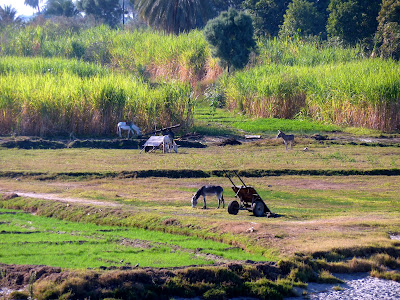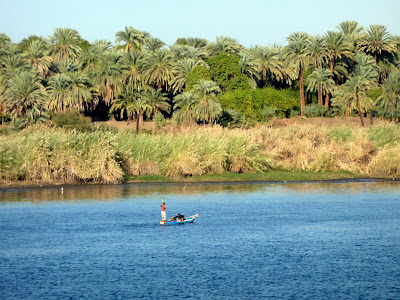 |
| My brother Steven enjoying the ride |
When Eden and I first thought of sailing down the Nile, we envisioned a small felucca, basic and unassuming but graceful and authentic. We certainly did not envision a large luxury cruise ship with all the amenities. Wow, were we wrong! Much to our kids' delight, we opted for the Sonesta Moon Goddess, a floating five-star hotel with an extensive buffet and a swimming pool. Sipping Stellas and Saqqaras (Egyptian beers) on the sundeck wasn't so bad for the adults either. But it wasn't just about a few days of mindless sun, fun and relaxation - although that was a key part of the journey. I kept my camera at my side at all times (ok, so I'm a little obsessive) to catch the captivating scenery along the banks of the Nile: colorful villages, local scenes of fishing, farming and praying, animals grazing and drinking from the river, boats of all kinds, historic rock-cut tombs, picturesque layers of land and water, lush greenery along the river's edge, and barren, endless desert mountains beyond.
 |
| Jeremy and Hayley enjoying the pool |
 |
| I love my cousin Will, but I do have one thing to say: "GO SF GIANTS!" |
 |
| Prayer sequence 1 of 3 (watch the man in the middle) |
 |
| Prayer sequence 2 of 3 |
 |
| Prayer sequence 3 of 3 |
 |
| Talia enjoying the sun by the pool with Will in the background |
 |
| Jeremy and Will playing on the iPad |
 |
| Ah, the good life! |
 |
| Hayley and Talia drying off by the side of the pool |
 |
| Sunset on the Nile |
One of the most entertaining parts of the journey was passing through the large lock at Esna to proceed upstream to the south. In an amusing and frenetic ritual that occurs many times each day (there are hundreds of cruise ships on the Nile), local merchants bring their small boats right up to the edge of the ship and throw their merchandise on board in hopes of a buyer. "Wow, I've been looking for that carpet forever and was hoping to find it while floating on the Nile." If you don't want the tossed merchandise, you're supposed to throw it back to its sender, who is screaming for payment in his boat below.
 |
| The guy in the back has a really strong arm |
 |
| Edfu Temple |
As you might expect, there's also plenty of ancient Egyptian history along the shores of the Nile to the south of Luxor. We made two temple stops, the first at Edfu, which is the second largest temple in Egypt (after Karnak in Luxor) and one of the best preserved. Compared to the temples of Luxor, the temple at Edfu is of relatively recent construction, built from 237 to 57 BCE. It's dedicated to the falcon god Horus, one of the oldest and most significant deities in the ancient Egyptian religion. Horus is now the symbol for Egypt Air, which makes sense given that he was the god of the sky and of unexplained delays. Over the centuries, the temple became buried to a depth of almost 40 feet beneath drifting desert sands and layers of silt deposited by the Nile. It was rescued by a French Egyptologist in the 19th century. It's an incredible edifice, with fantastic reliefs, despite the vandalism wrought by early Christians who sought to destroy the pagan religious imagery.



















 |
| Local scene near the temple |
 |
| View from the boat |
The second temple stop was at Kom Ombo, which is dedicated to two gods - the crocodile god Sobek and Horoeris, a form of Horus sometimes referred to as Horus the Elder. (I'm actually now a form of Marc sometimes referred to as Marc the Elder.) Built during roughly the same general time period as Edfu, Kom Ombo is unusual in that it's perfectly symmetrical along its main axis. It's believed that the temple was also used as a hospital, and several reliefs on the temple walls depict medical procedures and implements. The temple is dramatically perched along the Nile, so some in our group (the children) chose simply to gaze at it from the boat. Much of the temple has been damaged over the centuries by the Nile, by early Coptic Christians, and by builders who used the stones for new construction elsewhere.
 |
| Our excellent guide Nader |
 |
| My brother walks like an Egyptian |
 |
| Painted ceiling |
 |
| Kom Ombo maternity ward |
 |
| Picturesque scene in Aswan |
Our cruise concluded in Aswan, which lies along an attractive rocky bend in the Nile. It rarely rains here (it's one of the driest inhabited places in the world), but there's plenty of water. Aswan is the site of the High Dam, which was built in the 1960s to regulate flooding, provide for the storage of water for agriculture, and generate electricity. Damming the Nile created Lake Nasser, one of the largest human-made lakes in the world. This massive public works project threatened to flood a host of ancient Egyptian monuments - in an equally massive rescue effort overseen by UNESCO, many temples were moved to dry ground before the water reached them (although a number of monuments were swallowed by the rising waters). We saw two of the rescued temples (Philae and Kalabasha) from the road while driving around town. We also saw the "Unfinished Obelisk," the largest known ancient obelisk in existence, which was so big they couldn't even get it out of the rock quarry from which it was cut. If finished, it would have been 140 feet tall and would have weighed nearly 1,200 tons. The bottom of the obelisk is still attached to the bedrock and marks from workers' tools are clearly visible, offering valuable insights into ancient Egyptian stone-working techniques. We capped our day in Aswan with a delicious Nubian feast of stewed chicken, beef, fish and vegetables, on a picturesque island in the Nile.
 |
| Philae Temple |
 |
| Kalabasha Temple with dredging equipment in the foreground |
 |
| The Unfinished Obelisk |
 |
| Uh oh, I hope Eden doesn't want another baby! |
Our Egypt blog comes to a close in Abu Simbel, a short flight from Aswan. Abu Simbel, which lies on Lake Nasser about 30 miles from Egypt's southern border with Sudan, is the site of what is possibly ancient Egypt's most glorious temple. The site actually includes two different temples, which were carved out of the mountainside during the reign of Ramesses II in the 13th century BCE, as a lasting monument to himself and his queen Nefertari, to commemorate his (alleged) military victories, to intimidate his southern neighbors, and to reinforce the status of Egyptian religion in the region. The larger of the two temples is a miraculous sight to behold. The facade is graced by four 20-meter high statues of Ramesses and the dramatically light interior (where sadly no pictures are allowed) contains some of the grandest and most refined artwork in all of Egypt. And the temple is so precisely oriented that on two days out of the year,
the first rays of the morning sun shine down the entire length of the interior to illuminate the back wall of the innermost shrine and the statues of the gods seated there, except for the statue of Osiris, the god of the underworld, who always remained in the dark. It was a long and exhausting day, and Jeremy didn't want to go, so Eden made a bet with him that he would be amazed. When we turned the corner to face the colossal likenesses of Ramesses, I asked Jeremy if he was amazed, and he responded: "Yes, it's amazing. But don't tell Mama, because I made a bet with her, and I don't want to lose."






 |
| Steven and Amanda series: 1 of 4 |
 |
| Steven and Amanda series: 2 of 4 |
 |
| Steven and Amanda series: 3 of 4 |
 |
| Steven and Amanda series: 4 of 4 |
 |
| Nighttime view (taken from the internet) |
Here are some interior shots, which I found on the internet:
 |
| Aerial view of Lake Nasser (photo by Jeremy out the airplane window) |
The relocation of the two temples at Abu Simbel in connection with the construction of the Aswan High Dam was as significant an achievement as the original project was more than 3,000 years ago. Between 1964 and 1968, the entirety of both temples was carefully cut into large blocks averaging about 20 tons each, then dismantled, lifted and reassembled in a new location about 200 feet higher, as part of a human-made mountain meant to recreate the original topography, while avoiding inundation of the temples by Lake Nasser. The relocation is widely regarded as one of the greatest challenges of archaeological engineering in history. It's difficult to imagine in today's world the degree of international commitment, contribution and coordination that was necessary to achieve this feat.
 |
| Talk about a face lift (old photo taken from the internet) |
 |
| Lake Nasser (view from Abu Simbel) |
 |
| Another shot of Lake Nasser from Abu Simbel |
So that's it for the Bruner Family Egypt Extravaganza. It was a once-in-a-lifetime adventure, a great learning experience for the children and the adults, a fascinating look into one of the ancient world's most powerful civilizations, and a whole lot of fun. And the journey continues in Istanbul...

































































































No comments:
Post a Comment